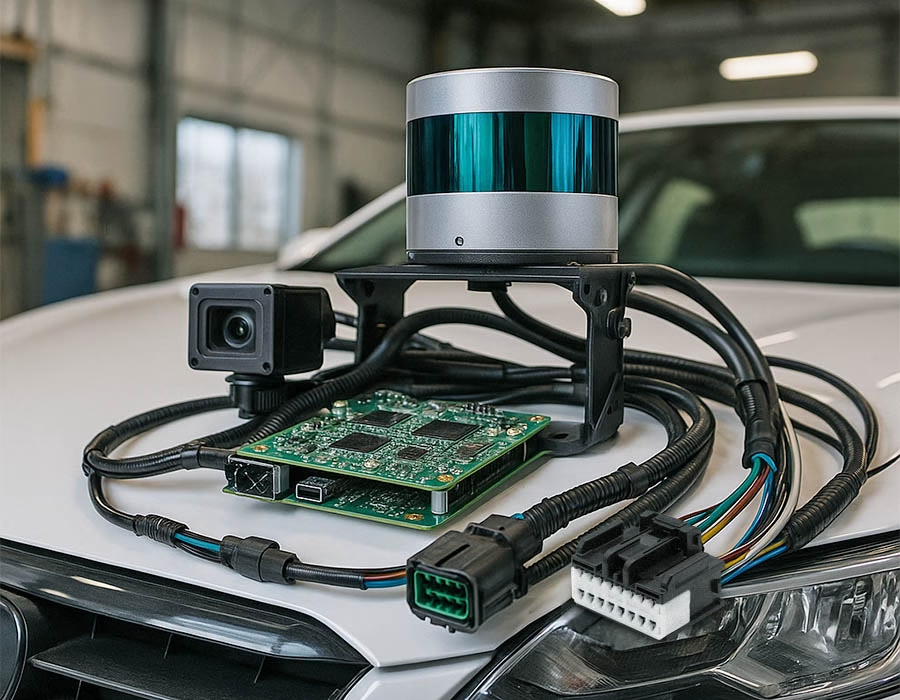
A wiring harness is a bundle of wires and connectors that routes power and signals cleanly in a system. In automotive, defense, and robotics applications, advanced sensors such as radar and LiDAR are commonly used. As autonomous vehicles and drones proliferate, demand is soaring for reliable sensor harnesses (the global LiDAR market is forecasted to grow from ~$2.4B in 2024 to ~$13.7B by 2033).
These systems require meticulous harness design so that power, data, and timing signals remain intact. Romtronic specializes in such custom wire harness solutions.
Radar Wire Harness Solutions
Radar sensors (used in ADAS, UAVs, and defense) transmit RF waves to detect obstacles. The radar wire harness delivers power and digital signals to these units, often in tight vehicle spaces. High-performance connectors are essential. As Molex notes, “integrating radar sensors in vehicles requires connectors that can handle space constraints and environmental stresses while maintaining precise signal quality”.
In practice, harnesses use shielded twisted pairs and sealed automotive connectors to resist vibration, moisture, and heat. Romtronic’s automotive harnesses meet these demands – they are ISO/TS16949 certified and undergo rigorous continuity, high-voltage, and insulation tests.
Laser & LiDAR Harness Solutions
LiDAR (Light Detection and Ranging) relies on laser pulses for high-resolution mapping. Harnesses for laser and LiDAR sensors must integrate power, high-speed data, and trigger signals in a single assembly. Poor isolation between power leads and data pairs can cause crosstalk or spikes, degrading performance. Practical design, therefore, begins with functional partitioning and overmolding.
For example, Romtronic’s mixed-signal overmold encases both power and Gigabit Ethernet lines in a single, rugged jacket, while keeping them internally separated. Harnesses must also accommodate specific connectors (such as IP-rated RJ45 jacks and JST sync pins) and meet the bend-radius and waterproofing requirements of the sensor.
Because LiDAR often operates on autonomous vehicles or drones, these harnesses must survive extreme conditions. They are designed to meet automotive reliability standards (ISO 16750) and even LV124 (VW80000) tests.
In practice, this means utilizing high-temperature insulations (PTFE, FEP), overmolded strain reliefs, and robust jackets to ensure that connectors and cables can withstand vibration, dust, salt spray, and thermal cycling. Romtronic can incorporate reflective thermal sleeving or aramid-reinforced jackets to strike a balance between thermal protection and low weight.
Key Harness Design Considerations
- Rugged Materials & Testing: Harnesses for radar and LiDAR must withstand heat, moisture, vibration, and shock. Designers use high-temperature insulations (PTFE/FEP) and Kevlar or nylon sheathing, and they validate assemblies against standards like ISO 16750 or MIL-STD tests.
- EMI Shielding & Signal Integrity: High-speed data pairs (such as Ethernet and USB) require shielding to prevent electromagnetic interference. Engineers simulate coupling early and wrap data lines in braided foil or mesh that terminates at chassis grounds. Proper cable routing and impedance control (100 Ω differential for Gigabit Ethernet) are also crucial for achieving low-loss transmission.
- Modularity & Diagnostics: Modern harnesses often employ a modular architecture, featuring separate pigtails to sensors, mid-line junction boxes (IP67), and bulkhead interfaces. Inline diagnostic test points can be embedded in overmolds to allow live impedance or TDR checks without disassembly. This segmentation (with field-replaceable sections) reduces maintenance downtime.
Romtronic’s Custom Harness Solutions
Romtronic has over 28 years of experience in OEM/ODM wiring harness production and is certified to ISO 13485 (medical) and IATF 16949 (automotive) standards. Global brands such as Siemens and Bosch trust Romtronic for their wiring harness components. Our company offers end-to-end custom harness manufacturing, from design and prototyping to automated wire processing and overmolding to rigorous 300% testing. Romtronic engineers work closely with customers to select connectors and cables and optimize layouts to ensure optimal space and reliability.
Whether it’s for an ADAS radar, a naval laser rangefinder, or an industrial LiDAR scanner, Romtronic’s custom wire harness solutions deliver the performance needed. Each harness is built to meet specific requirements – wire gauge, length, shielding, and connector types are chosen to match the application. The result is a harness that ensures stable data flow and robust power delivery under the harsh conditions of automotive, defense, or robotics use.
Choose Romtronic as your partner for wire harnesses in sensor systems. Our proven expertise in overmolding, shieldin,g and quality control means your radar or laser sensor harness will perform reliably in the field. Contact Romtronic today to discuss your project and get a custom quote for a precision-engineered harness assembly.
.avif)
Alex Wang is the Marketing Manager at Romtronic, with a degree in International Business and over seven years of experience in the electronic cable and wire harness industry. He leads marketing efforts across North and South America, combining deep industry knowledge with strong sales experience.
In addition to overseeing global marketing strategy, Alex is also responsible for content development and editorial coordination, ensuring that Romtronic’s messaging remains clear, consistent, and engaging. His strength in market analysis and customer-focused approach helps clients make more informed purchasing and sales decisions.


